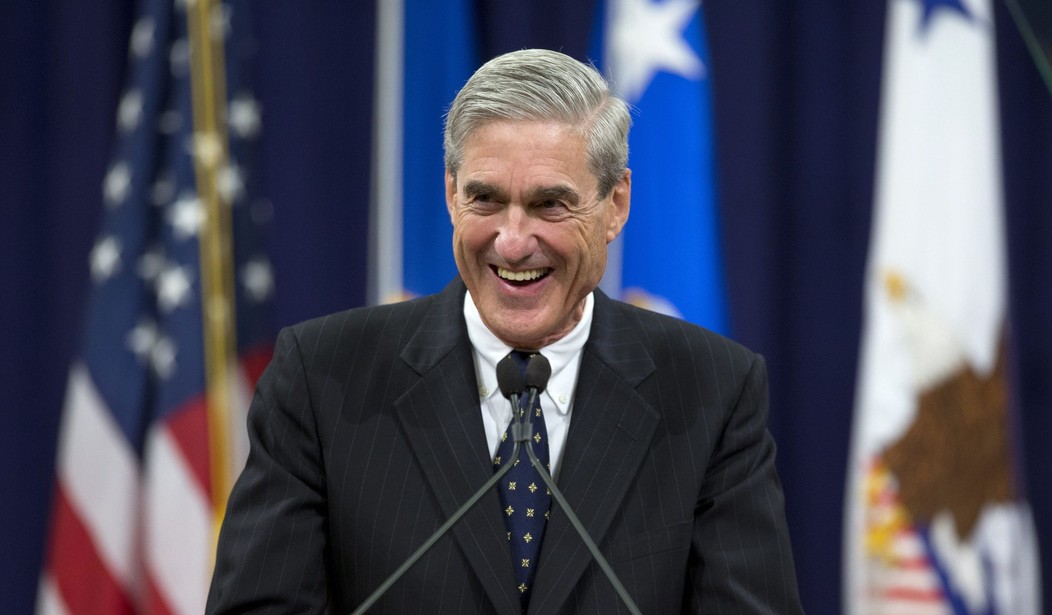The FBI had a human source in the Trump campaign, and nearly everyone commenting on it is wrong. This will set the record straight.
On July 31, the FBI opened a counterintelligence investigation into Russian interference in the election and possible collusion with the Trump campaign. Before launching the full investigation, the FBI sent a confidential human source (CHS) to spy on a Trump campaign adviser. The CHS was reportedly Stefan Halper, a slick political operative for past GOP campaigns and a foreign policy expert with extensive CIA and MI6 connections.
Halper is the latest twist in a Trump-Russia collusion narrative that has been peddled past its expiration date. The question is, did the Obama administration have the authority to spy on the Trump campaign? The answer is—sort of, but not really. The devil, as they say, is in the details.
As stated by FBI Director James Comey, the investigation into Russian interference and any links with the Trump campaign was not a regular criminal investigation but a “counterintelligence” investigation. A national security operation of this sort comprises three stages: threat assessment, preliminary investigation, and full investigation. The FBI Domestic Investigations and Operations Guidel (DIOG) has established specific requirements at each stage.
Assessing a Threat
The threat assessment stage begins when a concern is raised. It doesn’t take much, but it does require an “authorized purpose.” According to the DIOG, “The basis of an assessment cannot be arbitrary or groundless speculation.” You can’t just say, “My neighbor is a terrorist because he smells funny” and expect an assessment to be made. You have to have more, such as, “My neighbor who posts anti-American propaganda online is moving boxes in and out of his garage at night.” That’s some quality information. It could mean nothing. Maybe it is nothing, but it’s cause to check it out.
The purpose of an assessment is to find information on and possibly prevent “federal crimes or threats to the national security.” These include “international terrorism; espionage and other intelligence activities, sabotage, and assassination, conducted by, for, or on behalf of foreign powers, organizations, or persons; foreign computer intrusion, and other matters determined by the Attorney General, consistent with Executive order 12333” (on powers and responsibilities of intelligence agencies).
At the assessment stage, investigators want to discover whether there’s any credible information that someone is an agent of a foreign power who is committing or about to commit a crime that puts national security at risk. They are also looking for information on any individual or group that is the target of international terrorism, espionage, foreign computer intrusion, or other threats to national security.
As an agent of a foreign power, individuals “knowingly engage in clandestine intelligence gathering activities, sabotage, international terrorism, or taking on a fraudulent identity for or on behalf of a foreign power, which may involve criminal-law violations”—or anyone who knowingly conspires with the foreign agent.
The threat assessment stage of the FBI’s investigation in 2016 likely occurred sometime in late winter/early spring because former Attorney General Loretta Lynch testified that she met with Comey about the intelligence “matter” during this period. At this early stage, she and Comey decided not to tell the Trump campaign about possible national security threats regarding his campaign. When the topic was revisited in late spring, they again decided to say nothing.
This choice to remain silent was a deviation from established guidelines. Investigators are tasked with “detecting and interrupting criminal activities at their early stages, and preventing crimes from occurring in the first place,” which is much more preferable than “allowing criminal plots to come to fruition.”
According to the DIOG, assessments and investigations should be proactive to stop crimes or “national security-threatening activities.” In other words, law enforcement can’t just sit back and eat popcorn while they watch subjects weave their way toward a crime, so they can catch them in the act. The purpose of law enforcement is to actively stop danger in its tracks, not urge it on with passive observation.
Considering that the sanctity of a national election was at stake, investigators should have immediately informed the campaigns of the potential threat. Both CIA Director John Brennan and DNI James Clapper admitted to Congress that they had “concerns” about collusion, but they didn’t see any “evidence of collusion.” These concerns should have translated into warnings to the campaign. Instead, the Obama administration “stood down” and watched these “activities” unravel. At worst, they possibly played a hand in creating circumstances to push the investigation forward into more serious stages that allowed for more intrusive techniques, such as spying.
On the Use of Spies
During the low-level assessment stage, there can be no use of a human source or undercover agent. It’s strictly forbidden. Only public records, information from other departments, voluntary interviews, etc., can be used at this stage. When the investigation transitions into the preliminary stage, the FBI can use “intrusive” undercover operations—a “spy” or an informant. The difference between a confidential human source and an undercover agent (or spy) is inconsequential regarding their intrusiveness because they’re both secretly gathering information.
There are, however, differences that are significant. As a counterintelligence expert explained to me, an undercover agent is certified and trained by law enforcement. This makes him reliable in the field and credible in a court, which is why investigators prefer to use them. A CHS, on the other hand, is not trained. He can be anyone, from shady individuals with criminal records of their own to “concerned citizens” who live up the street. “We want to get the CHS out of the field as soon as possible and get in an undercover agent, because we always have an eye to a court case coming in the future and we don’t want to risk compromising it,” my source said.
Instead of using a qualified undercover agent, the FBI used Halper. This would have been understandable if the probe had merely been a low-level investigation without international implications. But, using Halper was tricky, not only because it was in the middle of a political campaign involving spying on an opposing campaign, but because sending an informant into the international arena to gather information is risky.
Halper reportedly made his first contact with campaign foreign policy adviser Carter Page on July 11, 2016, at a Cambridge symposium in England. Later, in September, Halper also met with campaign adviser George Papadopoulos in England, fishing for information about hacked emails.
Using a CHS on an international stage is less than optimal because they are not trained as undercover agents. The last thing the FBI or the U.S. government wants is an international incident if the CHS slips up while he’s trying to dig up information on Russia. Due to the risk, approval for this action must be obtained high up the chain of command, including the CIA. John Brennan, the anti-Trump and highly politicized CIA director, would have been integral in that approval process.
Why did Brennan send a CIA crony with a shady past abroad to spy on a political campaign adviser? Could it be that Halper’s purpose wasn’t to discover information, but to twist it, to manipulate his targets to bend to the Trump-Russia collusion narrative, something a qualified undercover agent wouldn’t do? Was he looking to set someone up as a foreign agent instead of merely gathering information?
To begin a preliminary investigation, there must be “information or allegation” that someone was acting as an agent of a foreign power and a threat to national security. According to my source, this isn’t a very high bar to reach, but it can’t be just any allegation. There must be “articulable information” that would stand up in court. “Remember,” the expert said, “we eventually have to make the case to a jury, and we want to have legitimate reasons for what we did every step of the way.”
Pushing the Investigation Forward
What moved the threat assessment to the preliminary investigation in the spring of 2016? It couldn’t have been the hiring of Paul Manafort by the Trump campaign. There were no dots connected to a threat to national security, terrorism, sabotage, or any crime that would put national security at risk. Manafort was under suspicion of financial wrongdoing and was already being looked at by the FBI, but he had nothing to do with Russian interference in the election—a point supported by the fact that he has not been indicted for any crimes related to collusion.
It wasn’t the hiring of Carter Page. Regardless of his business interactions with Russians in the past—none of which has led to indictments against him—there was no information related to Page working as a foreign agent to threaten national security. There might have been whisperings of wrongdoing, but again, the dots needed to connect. There weren’t any.
The only event in the spring that created a legitimate reason to push the investigation forward was the hacking of the DNC computers. The FBI never examined the servers and DHS never examined the servers—only a private company with connections to the DNC and the Obama administration examined the servers. CrowdStrike, Inc. alone determined that the Russians were responsible.
This information would, no doubt, give the FBI reason to initiate a preliminary investigation into Russian interference. Whatever you believe about the identity of the hacking culprits after nearly two years of reports, we know the Russians meddled in the election to sow chaos. The opening of a preliminary investigation regarding this prong of inquiry was the right thing to do.
The second prong of the investigation, however, is the rub—links to the Trump campaign. While it is certainly in keeping with the DOIG to question people of all sorts in an investigation, even if they are not suspects themselves, there still must be a valid reason to use an intrusive method to obtain intel.
What information would have been known in late spring/early summer to justify these methods? Was it George Papadopoulos’s meeting with Joseph Mifsud and his promise of emails on Clinton and contacts with Russian government officials to discuss foreign policy? The FBI said it didn’t know about that meeting until late July when the Australians supposedly told them about it.
A criminal investigation into financial interactions between Trump Tower computers and Russian banks was happening, but this was reportedly in the preliminary stage and dropped when no evidence of a crime could be found. Still, this provides no dots between the DNC hacking by the Russians and the Trump campaign.
That being said, Halper’s spying on Page could have been part of the investigation into Russian interference alone and not collusion, but why send a spy into risky international territory to gather information from a periphery individual for this prong of the investigation?
Page gave a speech in Moscow, but that was his right as an American citizen. No conspiracy was evident. Christopher Steele’s unverified dossier paid for by the DNC and Clinton campaign accused Page of meeting with Russian officials during his Moscow visit in July—a visit that was independent of the campaign—but the FBI said it didn’t know about the dossier when the investigation started.
There was no articulable information of the Trump collusion prong of the counterintelligence investigation in late spring/early summer. A Russian lawyer with links to the same company that hired Steele for the DNC met with Donald Trump Jr. in early June, but no information was exchanged. Where was the threat to national security?
Collusion in an election doesn’t rise to that level. The counterintelligence expert I spoke with said, in his decades as an FBI agent, he never heard of political collusion amounting to a national security threat—political corruption maybe, but not anything requiring a counterintelligence investigation that involved spying on an administration’s political opponent.
It seems the FBI head honchos knew this to be the case. They didn’t have a reason that would stand up in court to justify sending an untrained CHS to England to spy on Trump advisers. Yet, the CIA director and others up the chain of command allowed it.
They allowed it despite the DIOG repeatedly saying that an investigation should use the least intrusive methods to gather information—this is true at the threat assessment stage through the full investigation stage. “If the threat is remote, and individual’s involvement is speculative, and the probability of obtaining probative information is low, intrusive methods may not be justified, i.e., they may do more harm than good.” Using a human source is an intrusive method and uncalled for in a sensitive environment such as a political campaign.
Pushing hard to advance the investigation in this way was inappropriate. Instead, the FBI should have approached the individuals and admonished them, told them their suspicions and stopped them in their tracks. A little confrontation goes a long way in preventing wrongdoing, my source said. This is in keeping with DIOG directives to de-escalate instead of escalate, prevent rather than promote, and protect privacy rather than use intrusive measures that are unnecessary.
The First FISA Request
In the midst of concerns about the election, the FBI was already investigating financial interactions between Trump Tower computers and Russian banks. The criminal investigation, however, went nowhere. They couldn’t push the preliminary investigation into a full-blown investigation. There wasn’t enough evidence, so it was dropped. Inexplicably, the FBI converted the criminal investigation into a counterintelligence investigation.
Using the national security arm of the government to root out criminal violations without evidence of a crime is a misuse of powers. Yet this is what happened. With no crime to pursue wiretaps, the FBI changed the rules of the game. They would now be looking for agents of a foreign power—an inquiry more in keeping with its goal to prove collusion between the Trump campaign and Russia.
In June, as part of the newly packaged counterintelligence, the FBI sought a FISA warrant to electronically surveil members of the Trump campaign and maybe even Trump himself, since he was named in the application. The court soundly rejected the request—something that rarely happens due to the somewhat rubber-stamping nature of the FISA court. Given the lack of probable cause to electronically surveil American citizens, the FISA court made the right decision.
The fact is, the FBI should never have sought a FISA warrant, not only because the criminal investigation failed, but because the counterintelligence investigation was in a preliminary stage. According to the DIOG, the FBI can use all methods of investigation at this stage “except mail opening, physical search requiring a Federal rules of criminal procedure Rule 41 search warrant or a FISA order, electronic surveillance requiring a judicial order or warrant.” The FBI sought a FISA warrant before it initiated a full investigation.
The outset of the investigation in 2016 was fraught with violations of guidelines, failure to intervene and prevent further damage, and the appearance of political decision-making at the highest levels of law enforcement. In the midst of a preliminary investigation into Russian interference, the FBI converted a criminal investigation into a counterintelligence investigation to seek a FISA warrant in violation of federal guidelines. When that effort failed, they sent a human source instead of a trained undercover agent overseas to spy on an American citizen, violating federal guidelines to use nonintrusive measures in the process.
Investigations are supposed to prevent harm. The FBI failed (or succeeded, depending on how you want to look at it). Harm has certainly been the result—harm to the credibility of the justice system, the sanctity of our electoral process, the viability of the presidency, and the stability of the civil society. This is nothing less than scandalous.
I write more about the tactics and motivations that transformed the counterintelligence investigation into one of the greatest political scandals in American history in the upcoming book “Spygate,” which I co-author with Dan Bongino and Matt Palumbo.









Join the conversation as a VIP Member